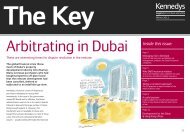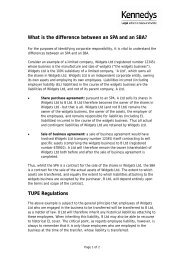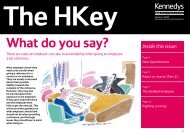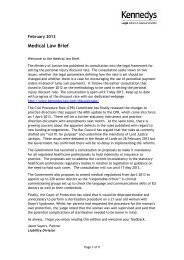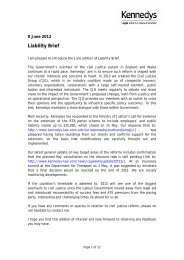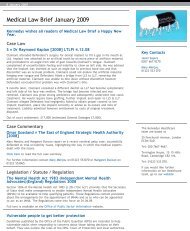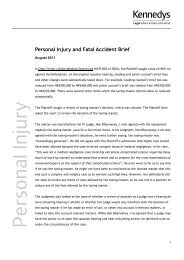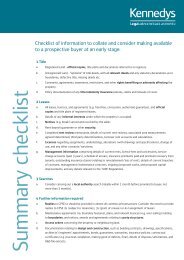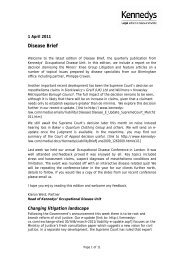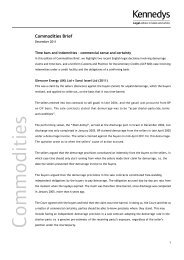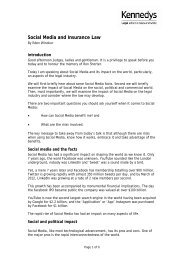Download The Key - Summer 2011 - Kennedys
Download The Key - Summer 2011 - Kennedys
Download The Key - Summer 2011 - Kennedys
Create successful ePaper yourself
Turn your PDF publications into a flip-book with our unique Google optimized e-Paper software.
<strong>The</strong> <strong>Key</strong><br />
July <strong>2011</strong><br />
Nano to Giga: When small becomes big<br />
Nanotechnological products carry significant insurance risks.<br />
<strong>The</strong>re are currently over 1,000 consumer<br />
nanotechnology products available on the<br />
global market and the number is only<br />
going to increase. <strong>The</strong> most conservative<br />
forecasts predict that the total global<br />
revenue for nanotechnologies will grow<br />
from around $2bn in 2007 to $81bn in<br />
2015 (see Nanomaterials and Markets<br />
2008-2015, Nanopost, quoted in<br />
Nanoscale Technologies Strategy 2009-12,<br />
Technology Strategy Board, September<br />
2009). <strong>The</strong> UK is ranked third in the<br />
world (after the USA and Germany) in<br />
terms of the number of operating<br />
nanotechnology companies.<br />
<strong>The</strong> rapid rise in nanotechnological products<br />
can be seen in many sectors, including food<br />
and beverages, pharmaceuticals and medical<br />
devices, animal health and feed, personal<br />
healthcare products, cosmetics, aerospace,<br />
energy, the automotive industry, construction,<br />
electronic consumer goods, textiles,<br />
chemicals, water and the environment.<br />
This article gives a brief overview of<br />
nanotechnology and nanomaterials; the<br />
recent developments when it comes to risk<br />
assessment of engineered nanomaterials,<br />
specifically in the food and feed industry; and<br />
the implications of nanotechnological<br />
products for the insurance market.<br />
What is nanotechnology?<br />
Nanotechnology is a field of science associated<br />
with the manipulation of matter on a moleculeby-molecule<br />
basis. Its aim is to improve<br />
product performance or to create new<br />
components (for example, computer chips) or<br />
other devices that are thousands of times<br />
smaller than are possible using traditional<br />
technologies.<br />
What is nanomaterial?<br />
In October 2010, the European Commission<br />
proposed an overarching definition of<br />
“nanomaterial” to help the development of<br />
new EU policies and regulatory regimes, as<br />
well as the implementation of existing rules. It<br />
was suggested that “nanomaterial” would be<br />
defined as any material that:<br />
(1) Consists of particles, with one or more<br />
external dimensions in the size range 1<br />
nanometer (nm) to 100nm for more than<br />
1% of their number size distribution; or<br />
Inside this issue:<br />
Page 3<br />
Close encounters of a less regulated kind<br />
Reverse mergers and backdoor registration<br />
Page 6<br />
Reducing the charges<br />
It is worth trying to persuade the prosecution to<br />
amend the counts in an indictment<br />
Page 7<br />
CBI Cover - are you aware of the pitfalls?<br />
Page 9<br />
For a short time only<br />
A recent Court of Appeal case sheds welcome light<br />
on time-limited settlement offers<br />
Page 10<br />
Who’s to say who’s an expert? – Part 6<br />
1
(2) Has internal or surface structures in one or<br />
more dimensions in the size range 1nm –<br />
100nm; or<br />
(3) Has a specific surface area by volume<br />
greater than 60 m2/cm3, excluding<br />
materials consisting of particles with a size<br />
lower than 1nm.<br />
However, the definition debate is still continuing.<br />
Inherent risks<br />
Reducing bulk material to the size of<br />
nanoparticles may cause it to behave differently,<br />
and to display completely unexpected<br />
properties. According to some studies, certain<br />
nanoparticles may cause adverse effects<br />
because of their small size and specifically<br />
manufactured properties. <strong>The</strong>re is also concern<br />
about the unknown consequences of exposure<br />
to these minute particles either by ingestion or<br />
absorption. This could happen in any number of<br />
different ways, either directly or via<br />
environmental exposure.<br />
Responsibility and research<br />
In order to evaluate the potential risks and safety<br />
aspects of nanomaterials and nanotechnological<br />
products, developments are being monitored<br />
internationally. For example, the OECD working<br />
party on manufactured nanomaterials (WPN)<br />
was established in March 2007 to advise on<br />
emerging issues in science, technology and<br />
innovation relating to the responsible<br />
development and use of nanotechnology. <strong>The</strong><br />
WPN works closely with national and European<br />
scientific advisory bodies, such as the European<br />
Commission’s scientific committee on emerging<br />
and newly identified health risks.<br />
In February this year, the US Environmental<br />
Protection Agency – in conjunction with the<br />
Consumer Product Safety Commission and the<br />
UK's Natural Environmental Research Council –<br />
awarded $12m to three consortia of leading US<br />
and UK universities and research centres. <strong>The</strong><br />
grant was to fund research aimed at achieving a<br />
greater understanding of the potential risks<br />
posed by engineered nanomaterials to both the<br />
environment and human health.<br />
<strong>The</strong> results of this research are eagerly awaited.<br />
<strong>The</strong> hope, of course, is that it will help the<br />
nanoindustries create safer nanotechnological<br />
products.<br />
Food and feed<br />
<strong>The</strong> consulting firm Cientifica estimates that the<br />
overall market value of food applications of<br />
nanotechnology will reach $5,800m by 2012.<br />
Nanofood is food that is cultivated, produced,<br />
processed or packaged using nanotechnological<br />
techniques. Nanostructured foodstuffs are<br />
usually used to enhance the taste, texture,<br />
flavour, digestibility and nutritional quality of<br />
food products.<br />
At present, there are only a few items – such as<br />
food supplements – containing nanomaterials in<br />
Europe. Most food sector products are currently<br />
available outside the EU.<br />
On 11 May <strong>2011</strong>, the European Food Safety<br />
Authority (EFSA) published a guidance<br />
document for the risk assessment of engineered<br />
nanomaterial applications in food and feed. <strong>The</strong><br />
EFSA describes the document as “the first of its<br />
kind to give practical guidance for addressing<br />
potential risks arising from applications of<br />
nanoscience and nanotechnologies in the food<br />
and feed chain”.<br />
<strong>The</strong> guidance recognises that there are gaps in<br />
scientific knowledge when it comes to the use of<br />
nanotechnology in food and feed. Professor<br />
Vittorio Silano, the chair of EFSA’s scientific<br />
committee commented on the publication of the<br />
EFSA guidance, saying: “We recognise<br />
uncertainties related to the suitability of certain<br />
test methodologies and the availability of data<br />
for engineered nanomaterial applications in food<br />
and feed”.<br />
For example, little is known about the effects of<br />
engineered nanoparticles in the dietary<br />
supplement market. Consumers are potentially<br />
exposed to unknown risks, which need to be<br />
balanced against the possible benefits of taking<br />
such supplements.<br />
<strong>The</strong> EFSA document provides guidance on<br />
several different fronts. It covers risk<br />
assessments for food and feed applications,<br />
including food additives, flavourings, enzymes,<br />
novel foods, food contact materials, feed<br />
additives and pesticides.<br />
<strong>The</strong> guidance says that nanomaterials should be<br />
characterised at five stages:<br />
1. When manufactured (pristine state);<br />
2. When delivered for use in food/feed<br />
products;<br />
3. When present in the food/feed matrix;<br />
4. When used in toxicity testing; and<br />
5. When present in biological fluids and tissues.<br />
Different tests for use when examining<br />
parameters are also outlined in the guidance.<br />
<strong>The</strong>se include tests for distribution, absorption,<br />
metabolism, in vitro genotoxicity, excretion and<br />
repeated dosage.<br />
According to the guidance, the testing<br />
approaches should take into account how the<br />
above parameters are influenced by the size,<br />
shape, solubility, surface charge and surface<br />
reactivity of nanomaterials.<br />
<strong>The</strong> guidance notably states that when there is<br />
“convincing evidence” that a nanomaterial will<br />
not migrate from food-contact materials – or<br />
will completely degrade or dissolve in the<br />
gastrointestinal tract without being absorbed –<br />
there may be no need for additional testing.<br />
However, if such data is not available, then the<br />
tests should follow the EFSA’s guidance.<br />
Risk to manufacturers and insurers<br />
When it comes to developing nanotechnological<br />
products, manufacturers and insurers in all<br />
sectors face risks and challenges. Manufacturing<br />
companies must ensure that nanotechnological<br />
products do not threaten their users directly or<br />
others passively. Further, as the nanotech<br />
market expands – and law and regulation<br />
evolves – manufacturers will have to conduct<br />
the necessary safety trials to show product<br />
safety and quality.<br />
It is also essential for UK manufacturing<br />
companies to keep up to date with legal and<br />
regulatory developments at a UK, EU and<br />
international level. This is necessary in order to<br />
ensure compliance and thereby minimise the risk<br />
of product liability claims arising from exposure<br />
to nanotechnological products either during<br />
their manufacture, or in the consumer market, or<br />
in the environment.<br />
2
Nanotechnology insurance<br />
In response to the increasing possibility of<br />
unanticipated nanotechnological risks, insurance<br />
companies are starting to create products to<br />
guard against such exposure. <strong>The</strong>se include<br />
underwriting nanorisks and developing risk<br />
management tools for nanotechnology.<br />
One insurance company has recently developed<br />
a web-based software product that looks at<br />
nanoparticle characteristics and is designed to<br />
help nanotechnology users determine potential<br />
hazard levels.<br />
Another insurance company has created an<br />
integrated coverage insurance policy specifically<br />
for companies whose principal business is<br />
manufacturing nanoparticles or nanomaterials,<br />
or using them in their processes. <strong>The</strong> policy<br />
provides protection for general liability, product<br />
liability, product pollution legal liability and<br />
product recall liability. It also deals with first<br />
party product recall, covering expenses incurred<br />
where a product containing nanoparticles or<br />
nanomaterials is recalled from the market for<br />
safety reasons.<br />
However, it is important to remember that while<br />
the materials themselves may be nano, the need<br />
for risk assessment and insurance coverage in<br />
this area may well become giga in the near future.<br />
Karishma Jasani<br />
London<br />
k.jasani@kennedys-law.com<br />
Anne Ware<br />
London<br />
a.ware@kennedys-law.com<br />
www.nanotechproject.org/inventories/consumer<br />
www.nanovip.com<br />
www.nanowiki.no/wiki/Applications_of_nanotechnology_for_the_food_sector<br />
Close encounters of<br />
a less regulated kind<br />
Reverse mergers and backdoor registration.<br />
Introduction<br />
<strong>The</strong> ‘alien’ is equally adored and vilified in<br />
American pop-culture, whether it be the<br />
moustachioed gun-toting Mexican bandito<br />
hot footing it over the border or the bug<br />
eyed, tentacle waving visitors from outer<br />
space. Corporate America now faces a new<br />
and real invasion by a class of aliens that<br />
are far dryer than either of these<br />
romanticised notions and whose whitecollared<br />
pursuits, whilst presenting a risk<br />
to the American investing public, would<br />
certainly not pique the interests of Messrs<br />
Mulder and Scully.<br />
<strong>The</strong>se ‘aliens’ are foreign companies, mainly<br />
Chinese businesses, that are obtaining a listing<br />
on US stock exchanges – and thereby access<br />
to American investors through “backdoor<br />
registrations”.<br />
What is a backdoor registration?<br />
A backdoor registration takes place when a<br />
privately owned business takes effective control<br />
of a publicly listed US shell company, thereby<br />
automatically gaining the public company’s<br />
listing on an American stock exchange.<br />
<strong>The</strong> way this is done is that the public shell<br />
company is actually the “acquirer” of the private<br />
operating business, which is treated as the<br />
“acquiree”. However, through a reverse merger,<br />
although the public company is the surviving<br />
entity, the private business’s board moves over<br />
to take control of the public company. <strong>The</strong><br />
“acquiree” then becomes the “acquirer” for<br />
accounting purposes.<br />
Right now, there is a rash of reverse mergers<br />
by Chinese owned private businesses on the<br />
lookout for publicly listed US shell companies.<br />
<strong>The</strong> Chinese buyers are assisted by US based<br />
promoters who identify suitable targets and<br />
arrange for a reverse merger to take place.<br />
Lack of scrutiny<br />
A reverse merger is an entirely legal way for<br />
companies to obtain listing quickly and more<br />
cheaply than the traditional Initial Public Offering<br />
(“IPO”) route. However, the reason they are<br />
cheaper and quicker than IPOs is that they avoid<br />
the scrutiny and rigorous due diligence<br />
associated with an IPO. <strong>The</strong> company is not even<br />
required to file a Registration Statement under<br />
the Securities Act 1933 or the Exchange<br />
Act 1934.<br />
Are Chinese reverse mergers a<br />
real problem?<br />
<strong>The</strong> short answer is, yes. In the US, both the<br />
Securities and Exchange Commission (SEC) and<br />
the Public Company Accountant Oversight Board<br />
3
(PCAOB) have launched significant<br />
investigations into the subject in the last year.<br />
In a recent research note, the PCAOB found that<br />
between January 2007 and 31 March 2010<br />
there was 603 reverse mergers. Most were<br />
entirely US based. However, of the total 603,<br />
159 were Chinese reverse mergers. Not<br />
surprisingly such figures are stimulating the<br />
current press interest in the trend.<br />
<strong>The</strong> lack of due diligence at registration does not<br />
necessarily present a problem. <strong>The</strong> main problem<br />
is that numerous Chinese reverse mergers have<br />
recently either been subject to de-listing or have<br />
seen trading in their securities halted. Primarily<br />
because of deficiencies in the audit procedures<br />
and irregularities in the financial statements of<br />
the Chinese reverse mergers.<br />
For example on 21 March <strong>2011</strong>, the SEC<br />
suspended trading in Heli Electronic Corp.<br />
because of concerns about the accuracy and<br />
completeness of the information in the<br />
company’s public filings relating to the<br />
company’s cash balances and accounts<br />
receivable. <strong>The</strong> company had also failed to<br />
disclose that its independent auditor had<br />
resigned due to accounting irregularities.<br />
Less than a fortnight later, the SEC suspended<br />
trading in RINO International Corporation. <strong>The</strong><br />
company had failed to disclose that the external<br />
law firm and forensic accountants hired by the<br />
company’s audit committee to investigate<br />
allegations of financial fraud at the company had<br />
resigned after reporting the results of that<br />
investigation to the board.<br />
<strong>The</strong>se examples reveal some of the investments<br />
dangers involved. For regulators, the key issues<br />
are protecting investors and making sure they<br />
are given material information that might inform<br />
their assessment of the companies. In the name<br />
of investor protection, the SEC recently revoked<br />
the registrations of at least eight Chinese<br />
reverse mergers.<br />
<strong>The</strong> contagion has now spread. Chinese reverse<br />
mergers and the difficulties they now find<br />
themselves in have started to cause problems<br />
for Chinese companies that have reached the<br />
American market through IPOs. <strong>The</strong>se<br />
companies have in recent months started to<br />
become the subject of speculative<br />
investor actions.<br />
Impact on London underwriters<br />
<strong>The</strong> listing of Chinese reverse mergers<br />
represents a real D&O risk even where the<br />
company is entirely legitimate. Indeed, there are<br />
claimant law firms in the US whose raison d’être<br />
is purely to commence class actions against<br />
publicly listed companies. Right now, Chinese<br />
reverse mergers are a favoured target and there<br />
are already several class actions in the US that<br />
have impacted on the London market.<br />
Over a quarter of such mergers since March<br />
2007 have involved Chinese companies. So it is,<br />
perhaps, not surprising to discover that, so far<br />
this year, Chinese reverse mergers have<br />
accounted for a significant proportion of the<br />
class actions commenced in America. As at 18<br />
April, 61 securities class actions had been filed in<br />
the US with 14 (or 23%) of those actions<br />
relating to Chinese reverse mergers. Of those 14<br />
actions, 10 were filed in the month of April.<br />
It would be all too easy for underwriters to be<br />
over-cautious and to simply turn their backs on<br />
Chinese companies seeking D&O cover at this<br />
time. However, that is simply not commercially<br />
viable given the obvious significance of that<br />
market and would be grossly unfair to the Chinese<br />
businesses seeking D&O insurance who are<br />
genuine. Underwriters can take steps to minimise<br />
their exposure to the risk that they encounter<br />
one of the few Chinese reverse mergers looking<br />
to take advantage of US investors.<br />
<strong>The</strong> warning signs<br />
<strong>The</strong> difficulty underwriters will face is the same<br />
as that the investing public and regulators in<br />
America have already encountered. On the face<br />
of it many Chinese reverse mergers look sound<br />
and present a compelling picture (and some, no<br />
doubt are sound). However, given that these<br />
companies are many thousands of miles away<br />
4
and with the associated language, cultural and<br />
regulatory differences and barriers it simply is<br />
not possible to absolutely verify the picture<br />
presented.<br />
Even the appointment of, and endorsement by,<br />
a large US auditor cannot be seen as conclusive<br />
proof that a Chinese reverse merger is a<br />
genuine concern with correct and true financial<br />
statements. Indeed there are a number of wellknown<br />
and highly regarded audit firms currently<br />
under investigation by the SEC for their part in<br />
failing to spot overstatements of revenue and<br />
other inaccurate financial statements put out by<br />
Chinese reverse mergers.<br />
Not wanting to milk the analogy too much,<br />
Chinese reverse mergers will not turn up<br />
asking to be taken to your leader, instead,<br />
think of it as the ‘Invasion of the Body<br />
Snatchers’. At first glance Chinese reverse<br />
mergers appear to be normal, reputable and<br />
healthy listed companies. But in reality they<br />
have been taken over and are controlled by a<br />
wholly different beast.<br />
From our review of the Chinese reverse mergers<br />
that have turned sour, we think the warning<br />
signs include:<br />
1. A recent listing in the US.<br />
2. Changes in (or resignation(s) of) auditors;<br />
and<br />
3. Incorporation in the British Virgin Islands or<br />
Cayman Islands (or other similar offshore<br />
jurisdiction) but with its main corporate base<br />
in China.<br />
<strong>The</strong> Proposal Form is your friend<br />
<strong>The</strong> Proposal Form and placing information<br />
should tackle:<br />
1. <strong>The</strong> question of listing in the US. Where<br />
listing has occurred, the prospective insured<br />
should be asked when and how it took place.<br />
2. If the prospective insured is a Chinese<br />
reverse merger then it would be prudent to<br />
ask questions about its US filing and<br />
regulatory history. In particular whether it<br />
has ever had to restate its financial<br />
statements, and whether it has ever had to<br />
restate or been the subject of regulatory<br />
investigations relating to the accuracy and<br />
content of its financial statements and filings.<br />
3. It would also be wise to examine closely the<br />
audit history of any Chinese reverse merger.<br />
In particular:<br />
●<br />
●<br />
●<br />
●<br />
Does the prospective insured retain local<br />
Chinese auditors and/or US auditors?<br />
Who presently acts as auditor and how<br />
long have they been in place?<br />
What are the prospective insured’s<br />
procedures for appointment and rotation<br />
of auditors?<br />
Have any auditors resigned or been<br />
replaced during the previous six years? If<br />
so, why did the auditor resign or why was<br />
it replaced?<br />
4. <strong>The</strong> detail of the prospective insured’s<br />
incorporation. This can be done by way of<br />
questions in the proposal form and requests<br />
for sight of incorporation documents.<br />
Conclusion<br />
Backdoor registrations and Chinese reverse<br />
mergers represent a serious risk both to<br />
investors and the unwary underwriter. While it<br />
is difficult to eliminate the danger entirely,<br />
underwriters can take action to minimise the<br />
risk provided they are alive to it and take steps<br />
to illicit further information from Chinese<br />
companies in respect of their audit history,<br />
incorporation, financial statements and<br />
registration in the US.<br />
This is not simply a hyped up conspiracy theory,<br />
it is a real risk and whilst it might not yet be time<br />
to don your tin foil hat every time a Chinese<br />
company comes looking for D&O cover, it is<br />
certainly time to exercise caution.<br />
Adam Edwards<br />
London<br />
a.edwards@kennedys-law.com<br />
John Bruce<br />
London<br />
j.bruce@kennedys-law.com<br />
5
Reducing the charges<br />
It is worth trying to persuade the prosecution to amend the counts in an indictment.<br />
A new offence of causing death by careless driving was<br />
introduced by the Road Safety Act 2006. It can be tried in<br />
either the Magistrates’ or the Crown Court and carries a<br />
maximum prison sentence of five years, along with<br />
obligatory disqualification.<br />
<strong>The</strong> new law was introduced because it was felt that the courts<br />
had inadequate sentencing powers in cases where a driver who<br />
caused a death was prosecuted simply with careless driving – a<br />
charge that did not take into account that someone had died and<br />
which carried only a fine and potential disqualification.<br />
<strong>The</strong> aim of the new offence is to ensure that drivers involved in fatal<br />
accidents received fair and proportionate sentences. However, the<br />
reality has been rather different. <strong>The</strong>re has been little consistency<br />
in the charging decisions made by the Crown Prosecution Service<br />
and the sentences eventually imposed by the courts.<br />
Given the legal distinctions between dangerous and careless<br />
driving, it is well worth challenging any questionable CPS decisions<br />
at each and every stage. Apart from anything else, there may well<br />
be significant costs consequences.<br />
Mr A’s case<br />
A recent case highlights some of the issues faced by lawyers<br />
dealing with road traffic law cases.<br />
Mr A was involved in a fatal accident on the motorway. CCTV and<br />
witness evidence revealed that Mr A – who was travelling in the<br />
inside lane – collided with the rear of a very slow moving vehicle<br />
ahead of him. Although Mr A was unharmed, the driver of the<br />
other vehicle tragically died and his passenger sustained lifechanging<br />
injuries.<br />
6<br />
Subsequent examination of the deceased’s vehicle showed that it<br />
had suffered a mechanical failure. At the time of impact, it was<br />
travelling at just 7mph. For reasons unknown, the deceased failed<br />
to manoeuvre onto the hard shoulder, despite ample opportunity<br />
to do so. <strong>The</strong>re was no evidence that the deceased’s vehicle<br />
displayed hazard warning lights.<br />
Mr A was interviewed and gave a plausible account of the collision.<br />
He accepted that, when he first saw the deceased’s vehicle, he<br />
misjudged its speed. He prepared to overtake it, looked over his<br />
shoulder to check the traffic flow but could not move out because<br />
two vehicles were already occupying the middle lane. When he<br />
looked back ahead, it was too late. CCTV footage demonstrated<br />
that he’d had approximately six seconds in which to see and react<br />
to the deceased’s vehicle immediately ahead of him.<br />
Despite the lack of aggravating features, the CPS then prosecuted<br />
Mr A for causing death by dangerous driving – an offence that<br />
carries a maximum sentence of 14 years’ imprisonment.<br />
At an early stage, representations were made to the Crown that<br />
the circumstances of the offence were more consistent with<br />
carelessness than with dangerousness. <strong>The</strong>se representations<br />
focused on the CPS charging codes and referred to several other<br />
cases – involving similar facts to Mr A’s case – that had been dealt<br />
with by the same CPS office and which had resulted in prosecution<br />
for the lesser offence.<br />
However, the CPS stood by its original decision, despite being<br />
shown expert evidence demonstrating that Mr A may, in fact, have<br />
had as little as two seconds in which to see the deceased’s vehicle.<br />
At every stage, the prosecution was repeatedly invited to review<br />
its position, emphasising that Mr A would plead guilty to the lesser<br />
charge. This was formally noted on the court file.<br />
<strong>The</strong> trial<br />
On the first day of the trial, the presiding Judge took the<br />
unorthodox decision of inviting the defendant to indicate his plea<br />
to the offence of causing death by careless driving, despite the<br />
fact that his admission of this charge was not acceptable to the<br />
Crown. <strong>The</strong> jury were therefore directed that Mr A accepted his<br />
driving was careless but not dangerous.<br />
Following a three-day trial, Mr A was acquitted of causing death
y dangerous driving. Turning to his admission of<br />
the lesser charge, the judge gave Mr A full credit<br />
for his guilty plea, recognising the persistent<br />
efforts made by the defence to prompt the<br />
prosecution to reconsider its case. <strong>The</strong> judge also<br />
referred to the helpful evidence given by<br />
witnesses and the police, which he took into<br />
consideration for sentencing purposes. He then<br />
sentenced Mr A to a community order and<br />
imposed the minimum period of disqualification.<br />
<strong>The</strong> judge next considered the question of<br />
defence costs, saying that if the prosecution had<br />
accepted Mr A’s plea to the lesser charge,<br />
considerable costs would have been avoided.<br />
Accordingly, he made a defence costs order,<br />
enabling the defence to recoup a proportion of<br />
the costs incurred in defending Mr A.<br />
Costs advantages<br />
This case shows that there can be significant<br />
advantages in trying to persuade the CPS to<br />
change its mind about the offence with which it<br />
charges a defendant – and continuing to do so<br />
right up to the trial itself. With the increasing<br />
pressures on CPS lawyers, it is clear that files are<br />
often being reviewed insufficiently. Defence<br />
lawyers should exploit this weakness to the full<br />
in order to maximise the chances of getting a<br />
good result and recovering defence costs.<br />
Naomi North<br />
London<br />
n.north@kennedys-law.com<br />
Mark Skinner<br />
London<br />
m.skinner@kennedys-law.com<br />
CBI Cover - are you aware of the pitfalls?<br />
<strong>The</strong> Japanese Quake.<br />
<strong>The</strong> Tohoku earthquake on 11 March was<br />
a magnitude 9.0 undersea earthquake<br />
that triggered powerful tsunami waves<br />
that travelled in shore, causing extensive<br />
damage. Media coverage was substantial,<br />
reporting the effect of the shutdown of<br />
the nuclear plants but also some<br />
conventional electricity supply plants by<br />
the Tokyo Electric Power Company.<br />
<strong>The</strong>re was also disruption to railways,<br />
with trains being cancelled or run<br />
less frequently.<br />
It appears the full magnitude of that disaster has<br />
not yet reached international shores, with much<br />
of the direct insurance exposure apparently<br />
contained in the Japanese market. However, the<br />
market is conscious of foreign reliance upon<br />
Japanese production, particularly in electronics<br />
and the automotive industry and is fearful of<br />
exposure to Contingent Business Interruption<br />
(CBI) claims.<br />
In March we heard press reports of reductions in<br />
car and steel manufacture.<br />
An article in the Economist online dated 19 May<br />
stated that the quake “ravaged the suppliers of<br />
critical parts and raw materials in north-eastern<br />
Japan”. <strong>The</strong>y commented further that: “it only<br />
takes one missing part to bring an assembly line<br />
stuttering to a halt”.<br />
So, what issues are likely to arise when<br />
considering CBI cover? Some guidance can be<br />
found in a consideration of an incident that<br />
occurred just over three years ago that had wide<br />
spread CBI consequences.<br />
On 3 June 2008, a gas explosion occurred at a<br />
facility on Varanus Island, off the North West<br />
Coast of Western Australia. As a result, Western<br />
Australia’s gas supply was reduced by<br />
approximately one third. Subsequently, a large<br />
number of claims based on contingent business<br />
interruption were notified to the London market.<br />
Significant commercial enterprises were<br />
interrupted or unable to function, because of the<br />
lack of gas coming from the facility. Whilst some<br />
gas was available by August 2008, this was<br />
insufficient to satisfy the requirements of all<br />
those who had contracted with suppliers. <strong>The</strong><br />
large number of claims demonstrated that the<br />
accumulation risk to insurers’ in respect of CBI<br />
cover should not be underestimated.<br />
How does the cover appear<br />
in the policy?<br />
In common with other “Anglo centric” CBI<br />
policies, in the standard ISR wording used in the<br />
Australian market place, CBI cover is provided by<br />
“Customer and Suppliers” and “Utilities”<br />
extensions. <strong>The</strong> terms of the Customers and<br />
Suppliers extension in particular could be wide or<br />
narrow, i.e. providing cover in respect of<br />
property owned, utilised or operated by any<br />
direct or indirect suppliers, customers etc.<br />
Subject to the operation of the other terms and<br />
conditions of the policy, these extensions<br />
provide cover for the insured in respect of their<br />
business interruption losses, resulting from<br />
material damage to the property of third parties.<br />
In order for a CBI claim to be indemnifiable, the<br />
requirement for physical damage to have<br />
occurred still exists. However the damage to the<br />
relevant property must also have resulted in an<br />
interruption to or interference with the business<br />
of the insured. Underwriters may have little or<br />
no knowledge of the third party property and<br />
the risks to it when agreeing to provide CBI<br />
cover, often subject to high sub-limits.<br />
This is an important risk management point. It is<br />
essential for underwriters to consider all of the<br />
potential CBI losses that could affect their<br />
insured’s business, when assessing whether or<br />
not to underwrite a risk and on what terms/at<br />
what rate. For example, does the insured have<br />
alternative sources of supply in the event that a<br />
major supply is interrupted? This situation came<br />
to the fore after the Varanus Island incident,<br />
when it became clear that it was extremely<br />
difficult to maintain supply to a vast and diverse<br />
array of businesses and residential customers.<br />
Named vs Unnamed:<br />
Direct vs Indirect<br />
CBI extensions often contain important terms<br />
which, perhaps because CBI extensions are often<br />
a “bolt on” to property policies, are undefined. It<br />
is important in assessing insurers’ exposure to<br />
7
consider applicable sub-limits e.g. for “Named” or<br />
“Direct” suppliers as opposed to “Unnamed” or<br />
“Indirect” because insureds usually have higher<br />
sub-limits for Named counterparties. Problems<br />
arise when they are not accurately described<br />
(for example referring to a particular company<br />
when it is actually a subsidiary or associated<br />
company which is in contract with an insured).<br />
Problems also arise in defining what proximity of<br />
relationship is required for a “direct” supplier<br />
when that is not defined. Is it a key supplier? One<br />
which is in direct contract with the insured? Or<br />
via a direct chain of contracts albeit via<br />
intervening parties?<br />
Policy terms that do not fit<br />
One of the problems with CBI cover arises from<br />
the fact that the underlying policy terms are<br />
designed to deal with the consequences of<br />
damage to the insured’s property and may not<br />
be as well suited to damage to a third party’s<br />
property. For example, the policy may impose an<br />
obligation on the insured to mitigate its loss.<br />
How can the insured do so when they have no<br />
control over and potentially no knowledge of the<br />
process and timeline of third party repairs?<br />
<strong>The</strong> policy may also contain a “Precautions to<br />
Prevent Loss” clause, under which the insured<br />
must use reasonable precautions to prevent loss,<br />
destruction or damage to the property insured<br />
by the policy. Arguably this clause is rendered<br />
useless in the context of a CBI loss.<br />
Concerns for the Adjuster<br />
A CBI loss may pose interesting legal questions in<br />
relation to the wording of the policy, but often it<br />
presents a significant challenge to the adjuster<br />
as well. Following the incident on Varanus Island,<br />
those adjusting CBI claims had no access to the<br />
site of the property damage. This made it<br />
8<br />
difficult for them to comment on the time-line of<br />
repair or to assess the appropriateness of<br />
decisions taken by the insured (themselves<br />
ignorant of repair timelines) on additional<br />
expense intended to avert BI losses.<br />
Even if information is available, adjusters may<br />
also find themselves constrained by the fact that<br />
information relevant to the adjustment may be<br />
commercially sensitive (i.e. contract prices) and<br />
the insured may be prevented or limited in what<br />
they can pass on due to confidentiality<br />
obligations.<br />
Contract pricing raises another relevant<br />
consideration in the adjustment of a CBI loss. We<br />
are all aware of the importance of “causation”.<br />
With the potential for commercial disputes over<br />
the price of products supplied to the insured and<br />
actions they may take that could affect and<br />
indeed increase the loss they suffer, adjusters<br />
must consider if the chain of causation has been<br />
broken, so as to minimise the insurable loss<br />
under the policy. We must always return to the<br />
question, was the insured’s loss caused by the<br />
relevant damage, rather than some extraneous<br />
cause such as a contractual dispute between<br />
supplier and insured, or insured and customer.<br />
CBI potential in the wake of Japan<br />
If a CBI loss arising from the incident is reported<br />
to insurers, obviously the potential operation of<br />
exclusions such as those relating to earthquake,<br />
tsunami, or nuclear risks will have to be<br />
considered. However, in addition, the terms of<br />
the relevant extensions and the chain of<br />
causation must also be reviewed. Insurers should<br />
look at what has actually caused the supplier (be<br />
it direct or otherwise) to cease or reduce supply<br />
to the insured.<br />
<strong>The</strong>re is also a serious issue to be considered<br />
(as it must be in any Property/BI loss involving<br />
widespread devastation) regarding the correct<br />
application of the “other circumstances” clause<br />
when looking at adjustments to “Standard<br />
Turnover” while assessing BI losses. What must<br />
be assumed not to have occurred? <strong>The</strong> peril? Or<br />
the damage to the third party’s property<br />
relevant to the operation of the CBI extension?<br />
<strong>The</strong> law on that issue is uncertain in many of the<br />
world’s premier “insurance law” jurisdictions.<br />
Matt Andrews<br />
London<br />
m.andrews@kennedys-law.com<br />
Alex Nurse<br />
London<br />
a.nurse@kennedys-law.com
For a short time only<br />
A recent Court of Appeal case sheds welcome light on time-limited settlement offers.<br />
In C v D [<strong>2011</strong>] EWCA Civ 646, D appealed against a<br />
decision that a time-limited offer to settle did not<br />
constitute a Civil Procedure Rules Part 36 offer. C had put<br />
forward the proposed settlement almost a year before<br />
trial. Described as a Part 36 offer, it was “open for 21<br />
days” from the date of the letter. Nearly a year later, just<br />
weeks before trial, D attempted to accept C’s proposal.<br />
<strong>The</strong> judge decided that a time-limited offer was not permitted<br />
under Part 36, as a Part 36 settlement proposal could only lapse<br />
upon service of a written notice of withdrawal. He ruled that the<br />
words “open for 21 days” meant that C’s offer lapsed without<br />
express withdrawal and consequently was time-limited. C’s<br />
settlement proposal was therefore not a Part 36 offer and not<br />
open for acceptance when D tried to accept it.<br />
Appeal ruling<br />
D successfully appealed against the decision. It was agreed that a<br />
Part 36 offer could not be time-limited. However, the Court of<br />
Appeal decided that, in the context of Part 36, it was entirely<br />
feasible and reasonable to read the words “open for 21 days” as<br />
meaning that the offer would not be withdrawn within that period<br />
of time, even though (under the CPR) such a withdrawal could in<br />
fact be effected with the court’s permission. “Open for 21 days”<br />
was simply a way of saying that there would be no attempt to<br />
withdraw the settlement proposal within that time.<br />
However, it was also a warning that, once those 21 days had<br />
expired, a withdrawal of the offer was on the cards. This<br />
construction did two things: it allowed the settlement proposal to<br />
count as a Part 36 offer, and it also gave the clarity and certainty<br />
that both Part 36 and the offer letter aimed to achieve. It left the<br />
offeror free to withdraw the offer immediately after the 21 days<br />
had expired, or to leave it open for as long as it wished. At the same<br />
time, it assured the offeree that it had 21 days to consider its<br />
position, while making it clear that the offeree risked the proposed<br />
settlement being withdrawn if was not accepted within that period<br />
of time.<br />
Lessons from the decision<br />
This decision provides some useful lessons for both Part 36<br />
offerors and offerees. In particular, it emphasises the importance<br />
of formally withdrawing a Part 36 offer if the offeror no longer<br />
wants it to be available for acceptance. If it is not withdrawn, an<br />
offer can be accepted at any time, so it may be worth carrying out<br />
a review of cases where Part 36 offers have been made – even if<br />
that was long ago – but have not been formally taken off the table.<br />
It may be, for instance, that new evidence has subsequently come<br />
to light which now makes the original offer less attractive for the<br />
offeror (in which case, it can be withdrawn) or, alternatively, more<br />
attractive to the offeree (in which case, its acceptance can be<br />
reconsidered). A Part 36 offer should therefore never be regarded<br />
as a fire-and-forget weapon.<br />
<strong>The</strong> lessons learned from Gibbon v Manchester City Council<br />
[2010] EWCA Civ 726 should also be borne in mind – namely,<br />
that a subsequent Part 36 offer does not cause an earlier offer to<br />
lapse. If an offer has not been withdrawn, it is still capable of<br />
acceptance, even if a further offer has been made. It is also wise to<br />
remember that, providing it has not been formally revoked, a Part<br />
36 offer can still be accepted even if it has been rejected<br />
previously. Withdrawal of an offer should be carried out by serving<br />
a written notice in clear, unambiguous terms.<br />
Conclusions from C v D<br />
What conclusions can be drawn from the Court of Appeal’s<br />
decision in C v D? It demonstrates the developing nature of Part<br />
36 offers, as well as the appellate court’s ability to apply common<br />
sense where before there has been confusion. While courts will not<br />
readily interpret a time-limited offer as not obeying Part 36 rules,<br />
the decision also emphasises the need for clarity and the risks of<br />
non-compliance with CPR requirements when making a Part 36<br />
offer. Of course, if an offeror wants to make a time-limited<br />
settlement proposal that simply lapses at the end of the specified<br />
acceptance period rather than being formally withdrawn, it is free<br />
to do so. However, such an offer will not provide it with the<br />
protection of Part 36.<br />
Miranda Cooke<br />
Birmingham<br />
m.cooke@kennedys-law.com<br />
Eamon Mooney<br />
Birmingham<br />
e.mooney@kennedys-law.com<br />
9
Who’s to say who’s an expert? – Part 6<br />
Paul Newman (1925-2008)<br />
In the sixth article in the series, we look at the use of expert evidence in the German courts.<br />
This time we head off to northern Europe, looking at<br />
the expert witness (Sachverständiger) in Germany.<br />
Although the system shares many common factors<br />
with other European jurisdictions, the German<br />
procedure – set out in §402-414 of the<br />
Zivilprozessordnung (Code of Civil Procedure) (ZPO)<br />
– has its own particularities.<br />
When can expert evidence be used?<br />
German courts will admit expert evidence where they<br />
consider the proof of facts or circumstances requires a<br />
special expertise or knowledge: §414 ZPO. Expert<br />
evidence is not limited to that produced for the present<br />
case. <strong>The</strong> court has a discretion to rely on relevant<br />
expert evidence presented in other cases: §411 ZPO.<br />
<strong>The</strong> use of expert evidence is generally governed by<br />
the rules on other witness evidence, subject to §403-<br />
414 ZPO: see §402 ZPO. <strong>The</strong> expert’s report has the<br />
status of formal evidence but does not bind the court.<br />
Its purpose is to assist the court in reaching its decision<br />
and the court retains full discretion as to the weight to<br />
be placed on it.<br />
How is the expert appointed?<br />
§ZPO provides for the appointment and number of experts, the<br />
court retaining discretion to appoint more, as the case demands.<br />
<strong>The</strong> trial court normally delegates the appointment to the judge<br />
responsible for supervising expert investigations who assumes the<br />
powers and duties of the trial court: §405 ZPO.<br />
Initially, the judge invites the parties to propose the names of<br />
potential experts, but may limit the number of choices. If the<br />
10<br />
parties agree a choice, the court will appoint that expert.<br />
<strong>The</strong> expert will, if possible, be appointed from publicly-maintained<br />
lists. Such experts are not subjected to the same qualification<br />
rigours as, for example, in France. Others may be appointed if<br />
special circumstances require it. <strong>The</strong> expert will usually have an<br />
academic degree in the relevant field. In most cases, they will be a<br />
professor at a German university or higher technical college or a<br />
member of a relevant institute or public body.<br />
<strong>The</strong> appointment of a court expert does not prevent the parties<br />
from presenting their own expert evidence. However, this only has<br />
the status of submissions by the parties.<br />
On appointment, experts must ensure the assignment falls within<br />
their expertise without the involvement of other experts.<br />
Otherwise, they must inform the court immediately: §407a ZPO.<br />
<strong>The</strong> expert cannot delegate their appointment but may employ<br />
staff to assist them.<br />
How do experts carry out their function?<br />
A court-appointed expert must be independent and impartial.<br />
<strong>The</strong> evidence is produced in response to issues designated by the<br />
court for assessment: §403 ZPO. Depending on the specifics of<br />
the case, the court may:<br />
●<br />
●<br />
●<br />
Hear the expert evidence before designating the issues to be<br />
addressed §404a(2) ZPO);<br />
If the facts are disputed, state the assumed facts on which the<br />
investigation will be based §404a(3) ZPO);<br />
Instruct the expert to involve the parties and determine the<br />
extent of their participation, including the calling of meetings<br />
with the parties §404a(4),(5) ZPO).<br />
If the expert is unsure about the content and scope of the<br />
appointment – or anticipates that the investigation costs are<br />
disproportionate to the value of the dispute or advance on the<br />
expert’s fees the court’s clarification must be sought immediately:<br />
§407a(3) ZPO.<br />
Although the court directs the expert’s activities, the expert<br />
decides without restriction how these will be carried out. For<br />
example, the expert may:<br />
●<br />
Carry out any inspections of (and tests on) the disputed subject
●<br />
●<br />
matter that are necessary to help form conclusions;<br />
Interrogate witnesses; and<br />
Demand further information and documentation.<br />
If the parties retain their own experts, these effectively<br />
shadow the investigation and can avail themselves of the<br />
same rights as the court expert. Additionally, the parties<br />
(either through their own experts or their lawyers) can make<br />
representations to the court-appointed expert.<br />
<strong>The</strong> court will stipulate a period within which the expert must<br />
complete their investigation §407 ZPO or – if they submit a<br />
written report (the more common requirement) – when they<br />
must file their signed report (see §411 ZPO). A written<br />
opinion must be in German and state that it is compiled<br />
impartially and to the expert’s best knowledge and belief. <strong>The</strong><br />
expert can make this declaration to the court at the outset of<br />
the investigation: §410 ZPO.<br />
On completing the investigation, the expert must return any<br />
documents, records or test results provided to them. Failure<br />
to file a report or return evidence can expose the expert to an<br />
order for costs and a fine: §409 ZPO. This is subject to a right<br />
of appeal.<br />
<strong>The</strong> court may summon the expert to explain the contents of<br />
their report. <strong>The</strong> court sends a copy of the report to the parties<br />
and sets a deadline for the parties to file objections – or raise<br />
any supplementary questions – arising from the document. It<br />
will also usually fix a hearing for the expert to attend for crossexamination<br />
by the parties on his or her report.<br />
In practice, the courts will rarely depart from the expert’s<br />
opinion when reaching its decision.<br />
How can the expert be challenged?<br />
An expert can be removed from office on the same grounds<br />
as a judge: §406 ZPO. <strong>The</strong> application can be made within<br />
two weeks of service of the order for the appointment. A later<br />
application can only be made if the applicant can prove that<br />
they were prevented, for reasons other than their own fault,<br />
from making an earlier application.<br />
<strong>The</strong> grounds for removal §41 and 42 ZPO are that the expert:<br />
●<br />
●<br />
●<br />
Is (or represents) a party in the proceedings, or their<br />
spouse or life partner (even if the relationship has ended) is<br />
a party in the case, or they are related by blood or marriage<br />
(within certain degrees) to one of the disputants; or<br />
Has participated in a previous action or arbitration<br />
proceedings about the same subject matter, other than as<br />
an expert; or<br />
Is suspected of partiality or bias.<br />
<strong>The</strong> fact that the expert has been questioned as a witness is<br />
not grounds for removal.<br />
How is the expert remunerated?<br />
Experts are paid on a scale according to the Judicial<br />
Remuneration and Compensation Act. <strong>The</strong>ir fees as treated as<br />
court expenses.<br />
Where a party is completely successful in its claim, the fees<br />
are met by the losing party. If the claim is only partially<br />
successful, the fees will be apportioned by the court between<br />
the parties.<br />
Mike Walker<br />
London<br />
m.walker@kennedys-law.com<br />
Visit our upgraded<br />
website!<br />
We have recently upgraded the<br />
functionality of our website.<br />
Review our enhanced knowledge<br />
section which includes a wide<br />
resource of our publications and<br />
articles, case reviews and events.<br />
www.kennedys-law.com<br />
11
United Kingdom<br />
International Offices<br />
London<br />
25 Fenchurch Avenue<br />
London<br />
EC3M 5AD<br />
T 020 7667 9667<br />
F 020 7667 9777<br />
DX 46628 London City<br />
Belfast<br />
5th Floor<br />
Lesley Buildings<br />
61-65 Fountain Street<br />
Belfast<br />
BT1 5EX<br />
T 028 9024 0067<br />
F 028 9013 5557<br />
DX 490 Nr Belfast<br />
Birmingham<br />
35 Newhall Street<br />
Birmingham<br />
B3 3PU<br />
T 0121 214 8000<br />
F 0121 214 8001<br />
DX Birmingham 013043<br />
Cambridge<br />
Terrington House<br />
13-15 Hills Road<br />
Cambridge<br />
CB2 1NL<br />
T 01223 533 060<br />
F 01223 533 076<br />
DX 5827 Cambridge<br />
Chelmsford<br />
Greenwood House<br />
91/99 New London Road<br />
Chelmsford<br />
Essex<br />
CM2 OPP<br />
T 0845 838 4800<br />
F 0845 838 4801<br />
DX 89702 Chelmsford 2<br />
Maidstone<br />
Victoria Court<br />
17-21 Ashford Road<br />
Maidstone<br />
Kent<br />
ME14 5FA<br />
T 01622 625 625<br />
F 01622 625 600<br />
DX 4811 Maidstone<br />
Manchester<br />
44 Peter Street<br />
Manchester<br />
M2 5GP<br />
T 0161 829 2599<br />
F 0161 819 2622<br />
DX 14388 Manchester<br />
Sheffield<br />
Ventana House<br />
2 Concourse Way<br />
Sheaf Street<br />
Sheffield<br />
S1 2BJ<br />
T 0114 253 2000<br />
F 0114 253 2001<br />
DX 10528 Sheffield<br />
Taunton<br />
Monmouth House<br />
Blackbrook Business Park<br />
Taunton, Somerset<br />
TA1 2PX<br />
T 01823 692600<br />
F 01823 692601<br />
DX 97187 Taunton<br />
(Blackbrook)<br />
Australia<br />
Level 31, Citigroup Centre<br />
2 Park Street<br />
Sydney NSW 2000<br />
Australia<br />
T +61 2 8215 5999<br />
F +61 2 8215 5 988<br />
Dubai<br />
902B Al Attar Business<br />
Tower<br />
Sheikh Zayed Road<br />
Dubai<br />
UAE<br />
T +971 4 325 4900<br />
F +971 4 325 4646<br />
Hong Kong<br />
11th Floor<br />
<strong>The</strong> Hong Kong Club<br />
Building<br />
3a Chater Road<br />
Hong Kong<br />
T 00 852 2848 6300<br />
F 00 852 2848 6333<br />
Ireland<br />
Ulysses House<br />
Foley Street<br />
Dublin 1<br />
Ireland<br />
T + 353 1 878 0055<br />
F + 353 1 878 0056<br />
Latin America<br />
Espirito Santo Plaza<br />
1395 Brickell Avenue<br />
Suite 610<br />
Miami, FL 33131<br />
USA<br />
T +1 305 371 1111<br />
F +1 305 374 8066<br />
New Zealand<br />
Level 6<br />
70 Shortland Street<br />
PO Box 3158<br />
Auckland<br />
New Zealand<br />
T 00 64 9 379 9011<br />
F 00 64 9 379 9025<br />
Portugal<br />
Av. Eng Duarte Pacheco<br />
Torre 1 - 5 piso, salas 5º e 6,<br />
1070-101 Lisbon<br />
Portugal<br />
T +00 351 213243690<br />
F + 00 351 213243699<br />
Singapore<br />
80 Raffles Place<br />
#44-05 UOB Plaza 1<br />
Singapore 048624<br />
T +65 6671 7400<br />
F +65 6671 7401<br />
Spain<br />
Paseo de Recoletos 27<br />
Planta 7<br />
28004 Madrid<br />
Spain<br />
T +34 91 523 7210<br />
F +34 91 523 7212<br />
We are very pleased and excited to say that in June we<br />
consolidated our relationship with O'Hare O'Connor Walshe in<br />
Dublin, Ireland by forming <strong>Kennedys</strong> Ireland and that we also<br />
formalised an association with Brazilian law firm, Torres,<br />
Marcellino & Associados (‘TM Law’) who have offices in<br />
Rio de Janeiro and Sao Paulo. Our Singapore office also<br />
moved premises.<br />
www.kennedys-law.com<br />
Associated offices Dubai, Karachi, Mumbai, New Delhi, Paris, Rio de Janeiro, Santiago, Sao Paulo and Warsaw<br />
For further information about any of the articles within this issue please contact the author concerned or your usual partner. This newsletter is designed to provide a summary of recent case law. It does not purport to be comprehensive or to offer legal advice. All rights reserved.<br />
<strong>Kennedys</strong> is a trading name of <strong>Kennedys</strong> Law LLP. <strong>Kennedys</strong> Law LLP is a limited liability partnership registered in England and Wales (with registered number OC353214).<br />
We use the word ‘partner’ to refer to a member of <strong>Kennedys</strong> Law LLP, or an employee or consultant who is a lawyer with equivalent standing and qualifications.



